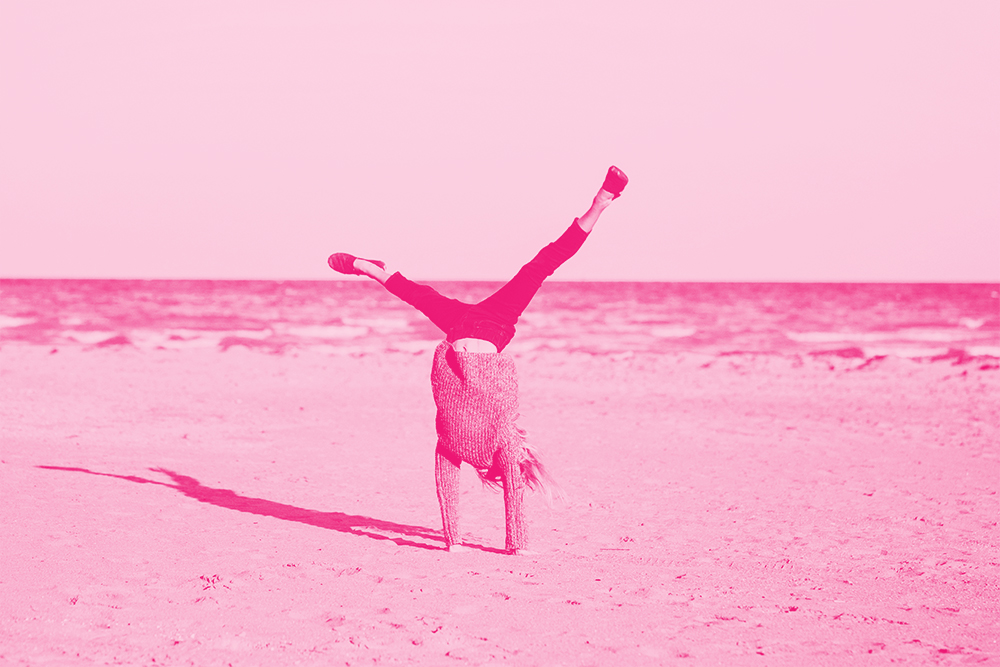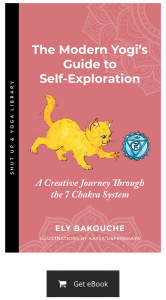“The piano ain’t got no wrong notes.”
– Thelonious Monk
Erich Schiffmann’s discoveries about self-practice have influenced and empowered thousands of yogis teaching and practicing today, culminating in a style he calls Freedom Yoga. This unpretentious teacher has left an enduring mark on a generation of yogis and teachers inspired by his take on making the shift from doing someone else’s yoga to doing your own.
Erich dismisses any notion that the term is proprietary to him. He winces at the idea that anyone might dub it “Schiffmann’s Freedom Yoga.” The term is a shorthand one he fashioned after growing dissatisfied with the elaborate answer he used to give to the “So, what kind of yoga do you teach?” question.
It’s not on Yoga Alliance’s list of choices in the “I Teach ______” menu dropdown. It’s not a flashy or a headline-attracting practice. Most freedom yogis are too occupied enjoying and learning from their practice to talk about it much. It’s an approach that’s made all the difference for me. In part because its specific expression varies so much from one practitioner to the next (that’s the freedom part), and also because its only canon is that ongoing inquiry is paramount (that’s the yoga part).

Erich arrived at Freedom Yoga decades after exploring yoga on a long and wandering learning trek that began when he was a teen. His early travels opened doors for extended personal study with legendary yoga and personal transformation teachers as diverse as B.K.S. Iyengar, T.K.V. Desikachar, Jiddu Krishnamurti, Dona Holleman, Vanda Scaravelli, and Joel Kramer.
His 1977 encounter with Kramer lit a game-changing spark in discovering his own practice. He learned to sense for the best intensity in each moment, moving into postures in search of what he calls “the line of perfect flow.” In his words, he “finally got how to do yoga” by following guidance from within. With contagious enthusiasm, he’s shared his evolving insights on just that ever since.
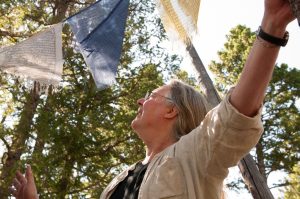
Freedom Yoga frames “technique” as a necessary, but temporary and perishable, stepping stone. The golden treasure beyond mechanical practice is the freedom unleashed from intuitive, intelligent, and continuous deep inner listening that informs each moment, and every decision about what to do next, on the mat. It doesn’t stop there: once it injects fresh life into asana, the sticky mat becomes a training site for experimenting with self-trust in other parts of life.
First, Freedom Yoga gives asana practice room to blossom. You start to “break the rules,” trust your inner authority and claim greater agency over your practice instead of handing it over to someone else. Once you get the hang of listening to and trusting your inner guidance system with asana and breath, it dawns as self-evident that the same source of intuition guiding where to put your hands in triangle pose — or how much breath effort is right in a backbend — might be trustworthy enough to steer your life off the mat.
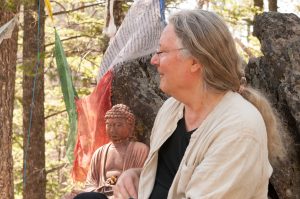
It’s like practicing in simultaneous collaboration with an invisible, trustworthy friend that has only your best interests at heart; an unseen friend who transmits cues to override ego and old habits.
When you don’t know what to do, you pause and ask, “What now?” Then you expect and wait for the answer and follow the “instruction.” You dare to do as your friend suggests. More and more, you set aside what it is you think you’re “supposed” to do on the mat in favor of your invisible friend’s counsel. You do that because your confidence and trust grow as you experience that she’s incapable of steering you wrong.
Eventually, there’s a recognition that your unseen friend is your truest self, and her insight is what’s been hidden in the shadows while you’ve dallied with your ego. Or spent coin on the latest book, video, or workshop to show you how to do it “right,” so you can, at last, enjoy a sustainable self-practice. Until that moment of recognition, it might feel like this deep inner listening amounts to you taking orders from another. Spoiler alert: there is no “other.”
Musical Mastery Metaphor
When someone first learns to play the piano, she might begin with basics about musical theory and reading simple sheet music. A teacher will steer her toward healthy ergonomic habits — basic training about posture on the bench and the distribution of the weight of her fingers on the keys.
Next, her teacher might assign an extended period of practicing simple scales, over and over, until both the gross and fine movements needed to produce organized sound are second nature.
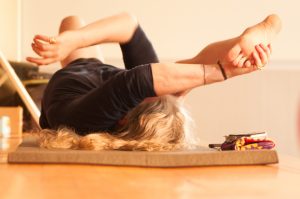
With practice, the student learns how to move her fingers over the piano keys in a coherent and organized rhythm. She starts to sense the placement of the keys in space without looking at them or thinking so hard. She learns how much pressure each finger needs to exert on a key to make a specific sound without cramping or over-exerting. The aim at this stage is for her to mimic a prescribed sequence of notes with comfort and reasonable competence.
But playing the scales isn’t as satisfying as making real music —that comes after she has a bit of scale-playing mastery under her belt and gets a little braver. Once she begins using her foundational knowledge to explore other possibilities for harmony and rhythm, everything changes. This is when random noise transforms into organized notes, organized notes shift into harmonies and rhythms, and finally harmonies and rhythms become the sound of music. And, one happy day, the prospect and process of creating and playing original compositions.
Other learning along the way informs the aspiring pianist about the mysteries of the instrument itself. The visible part of a key that a pianist presses to make sound appears to be only a small rectangle, but each key extends deep into the piano where it acts as a lever. That lever triggers a spring, which in turn causes a thin wooden stick with a ball of felt at its end (the hammer) to launch at strings to make them vibrate and create a specific sound. Then there are the foot pedals that raise dampers to allow the strings to sustain notes.

As she practices and gains a feel for how every hand and foot movement affects the piano’s anatomy to generate different qualities of sound, the piano itself transforms. Now it’s an extension of the melody longing for expression deep inside of her. It’s no longer a detached, separate tool to be conquered and controlled.
We know that two gifted musicians working from the same set of sheet music and playing the same song tease something different out of the same notes. Listen to Thelonius Monk play “Smoke Gets in Your Eyes” and then listen to Art Tatum play the same tune. Both are enthralling and divine and worthwhile — and they are as different as chocolate and cheese.
The sense of freedom swells when the pianist has the courage to begin to improvise, customize, tinker, and experiment. Technique has served its purpose and can drop away. Creativity rushes to take its place, with limitless possibilities for self-expression and original artistry. The piano player can continue to learn from the techniques of musicians that came before her, but she knows now how to transform that knowledge about method into imaginative combinations and compositions all her own. She’s found her inner teacher and is making her own music.

Discovering Your Own Practice – For Real This Time
Most of us learn yoga from a teacher, who, with any luck, shares intelligent principles about breath, alignment, and sequencing. The teacher might have the student begin with yoga’s version of musical scales — replicating simple patterns to imprint safe alignment habits and recognize the poses as shape-shifting containers for breath.
Just like the piano player tinkering with scales discovers that the same notes can have different qualities depending on how the keys are pressed, the attentive yogi senses that no two repetitions of the same sequence are identical.
Within the prescribed forms and templates lie an infinite variety of combinations. We begin to get more interested in this complex body instrument, including not just the parts that we can see, but also the parts we cannot: Keys, pedals, hammers, and strings. Limbs, muscles, bones, and fascia. Chord changes, syncopation, minor keys, and downbeats. Sequencing, breath, mudra, and drishti.
If we commit to ongoing curiosity about movement, pause, and breath, we notice how conscious choices shift our internal state. We can sense the connective tissue between those choices. When technique gives way to improvisation, the distinction between each discrete element and the whole itself dissolves along with it.
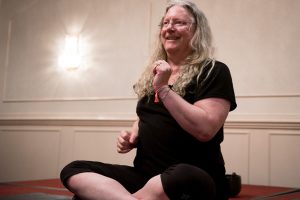
Graduating from Mimicry: Persist in Pursuing Your Freedom
Learning to imitate a prescribed practice is beneficial and instructive. A good teacher is indispensable when it comes to overcoming unhealthy habits, acting as an inspiring — and in the best scenario, temporary — stand-in for your inner teacher. A great teacher goads your active inquiry into discovery of your own invisible friend — and never claims to be its proxy.
Once you are comfortable with the fundamentals of safe practice, keep going. Don’t stop there. Don’t deny yourself of one of yoga’s most valued treasures: your own practice.
When a student is free to start tinkering with the same yoga song, but perhaps in a different key, the internal experience of the posture or movement can change in subtle or dramatic ways. The early shift away from mechanical practice toward intelligent, individualized investigation marks the moment when the yoga starts to become your own, not anyone else’s. As you discover movement, breath, and pauses most appropriate to the newest now, the full surrender into the experience of this sensual exploration is like making jazz.
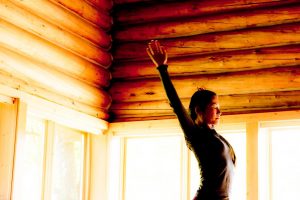
Practicing Freedom
Mastery in Freedom Yoga isn’t measured by levels of bendiness or facility with pretzel poses. If there’s such a thing as “progress” at all, it’s in the degree of willingness a practitioner brings to the mat to relinquish preordained decisions about what to do in any given practice. In order to “hear” your invisible friend, you have to listen. Which means having a quieted mind. Which means coming to the mat with a little more humility and a lot more receptivity than may be your habit.
Instead of pressing “play” on the old tapes (“today I’ll focus on strength, tomorrow is balance day”) and diving in, you ditch any plans and get quiet. You stop making decisions alone. And you ask and listen for what it is that your mind and body desire most at that moment. You wait for the opening beats of this new curriculum to be revealed.
You’re learning to read body-mind Braille. It takes patience and humility to develop the sensitivity to perceive and respond to these subtle inner cues. But remember: it’s within your capacity to do this. Your inner friend has been waiting a long time for this. She’s been yearning to be heard, and for you to dare to do as she suggests. This is what she lives for!
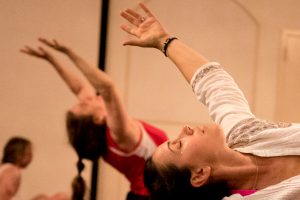
Here are two ideas for starting to incorporate elements of freedom into your practice:
Know that meditation is the bridge. Moving from mechanical practice to a freeform practice requests that you listen deeply. A quieted and receptive mind makes all the difference (Freedom Yoga knows that thinking too much is the soul’s kryptonite). For starters, insert breaks of tranquil stillness into your practice. Erich calls this the “conscious pause.” It’s a good way to notice the spaces that are eager for release. Expect, and listen for, a suggestion. It might come in the form of a whispered internal impulse to move or shift something, somewhere to erase a tight spot. Then keep on listening and stay on the ride. The more you do it, the easier it gets.
Don’t sweat about what it looks like. Nineteenth-century master composer Robert Schumann said, “When you play, never mind who listens to you.” Freedom Yoga invites you to shift your attention to internal sensations and leave aside what you think a shape is supposed to look like on the outside. The focus is on how it feels: think less, listen and feel more. You might move into a simple, familiar posture and start swimming around inside the shape to probe its options. Sense for choices that enable an easy, smooth flow of breath, or those that offer release in spots that feel contracted or muddy. Set yourself free to toss out some of the rules. Keep it simple at first: What happens if you turn palms up instead of down in Warrior II? How does your experience of triangle pose change if you rotate your head to look in different directions? After all, how do you think the first yogis did it? They didn’t have posture sequence charts or YouTube videos. They sensed into the movements and shapes that freed them.
Teaching Freedom
Are you ready to break with convention, at least a little? Encouraging students to integrate self-trust into their own practice can be a monumental gift, but at first, it can feel risky to implement. Many students aren’t accustomed to incorporating self-practice into a class where the expectation is that they’ll be following instructions from the external teacher from start to finish.
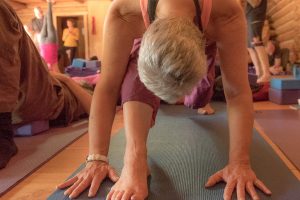
It’s one thing to champion the merits of self-practice, but what if we valued it enough to weave a bit of it into class time? No two Freedom Yoga-influenced teachers use the same approach when it comes to empowering students to tinker with self-practice, but here are a few starter ideas to play with:
Point out, and then fiddle with, options. When sharing a sequence or movement pattern, after a few repetitions, ask students to pause and experience the choices available within the rough draft of a pose. Erich, for example, asks students in table pose to move through the range of shoulder and upper body motion there. Press the arms firmly into the floor letting the upper chest and shoulders rise to feel the ‘up extreme’ and then let the chest glide down as the shoulder tips move closer to the ears for the ‘down extreme.’ Notice the range of possibilities between these extremes. Then linger in a sweet spot where the breath flows easy.

Encourage detours. After talking students through an easy sequence a few times, give them a chance to repeat it on their own, but with an invitation to take any detours tempting them along the way. In half-salutes, for example, what happens if you pause halfway down and add a mini-twist? How does it feel in triangle pose to rest the back of your bottom hand on your sacrum and let the top arm float in a slow circle overhead before settling into a spot where the sensation is delicious? How does it feel to invent a mudra with the shape of your fingers? Maybe the folks you’re sharing class with will invent something new during these detours, morphing into unexplored shapes where energy flows without effort.
Set aside a bit of class time for student self-practice. Pause the Simon Says style of teaching and summon students into a few minutes dedicated to self-practice, perhaps near the end of class. Some teachers toss a little music to the mix because it helps some people to get out of their heads. Keep it lighthearted, fun, and easy — and recognize that not every student feels comfortable practicing yoga without instruction. You can remind them that this is the time they can also use to repeat something they’ve already done in class while discovering variations, or to move into a favorite sequence, or to sit quietly and take in what’s unfolding in the room.
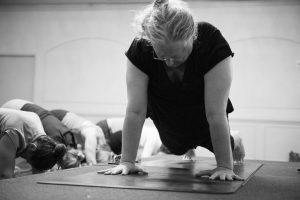
Living Freedom: When the Student is Ready, the Teacher Just Might Disappear
On a mild summer evening in July 2016, sitting in a circle with students and friends in Montana, Freedom Yoga’s leading light had a surprise announcement. A buttery sunset painted orange streaks on the floor of the yoga practice room as Erich drew in a long breath. After 43 years on the teaching circuit, he said on the exhale, his inner teacher was nudging him toward another kind of conscious pause — this one, from teaching.
His resolve to follow this guidance modeled what it is to live a guided life, steered by an invisible friend.
Students shared their sadness, leavened with gratitude, about not knowing when they might next have a chance to be with their teacher. Erich’s commitment to seeking truth — and sharing his insights with all of us wobbling toward home together on freedom’s training wheels — had been a reliable touchstone for many students for a lot of years. For some, decades.

Erich never pretended that he had it all figured out. Instead, he joined with students in a mutual commitment to investigate the truth, so they could learn and play together to help set each other free. He didn’t shy away from sharing tales of his own wobbles along the way.
There’s much to appreciate about a teacher like this.
We don’t know when or if Erich’s invisible friend might give him the green light to return to the teaching circuit. In these rugged times, heaven knows, plenty of us are thirsty for a refresher. Who wouldn’t want to hang out with an effervescent yogi-friend bubbling over with encouragement, nudging you to persist in seeking and finding “the line of perfect flow”?
If the hallmark of an outstanding teacher is how well they cultivate disciples of truth, then when I look around at all the freedom yogis that I know, and I see all the good works they’re doing in the world on and off the mat, I know that Erich is an outstanding teacher.
“We Are the Yogis on the Planet Now”
Outstanding teachers equip us with skills for reclaiming our agency and discovering our own practice. Our work is to be braver than we’ve ever been before. “We are the yogis on the planet now,” Erich likes to say. This means accepting a noble assignment — pursuing freedom from whatever blocks our recognition of the truth that it’s love that binds us and sets us free.

We’re in this together. It’s time to take off the training wheels and wobble into steadiness. We’ll wobble into grace first on the mat, and then in grocery store checkout lines and bus stops, at our jobs and in our kitchens, in voting booths and border towns. We’ll do it any place where there is a call for love.
Edited by Ely Bakouche
Enjoyed reading this article? Consider supporting us on Patreon or making a one-time donation. As little as $2 will allow us to publish many more amazing articles about yoga and mindfulness.

